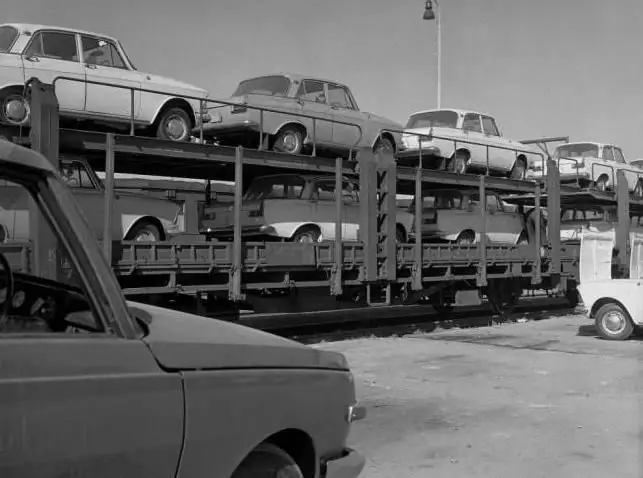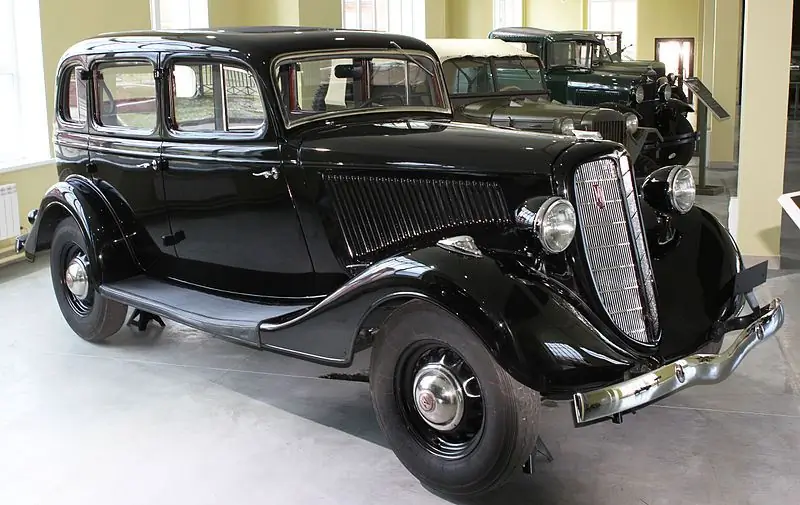2025 Author: Erin Ralphs | [email protected]. Last modified: 2025-01-22 21:14:09
GAZ is the largest automaker that started manufacturing products in the city of Nizhny Novgorod. In the first years of its work, GAZ produced "Ford" products. For the realities of the Russian climate, the engine of this series of cars did not fit well. As always, our specialists solved the task set, quickly and without unnecessary troubles, taking as a basis (actually copying) the new GAZ-11 engine, the American lower-valve Dodge-D5. Yes, it was an old model, but it showed itself only on the good side. Moreover, this "engine" was ideally suited to Marshal Voroshilov's requirements for a command vehicle, the creation of which was entrusted to GAZ.
History of Creation
The future winner of five Stalin Prizes, the leading designer of GAZ A. A. Lipgart, went to the USA in the mid-30s of the last century to get acquainted with the production process, including engines. Despite the existing formal agreement with Fordabout support in the creation of new models at GAZ, he chose the Chrysler engine.

Engine benefits
- The design is time-tested and almost ideally suited to the climatic conditions of operation in the USSR.
- The specific power is one and a half to two times higher than the current Ford and, accordingly, the Soviet GAZ-A and GAZ-M1.
- Manufacturability of this fairly lightweight design, weighing just over three hundred kilograms. With the exception of pistons, its production did not require non-ferrous metals, which were so scarce in the USSR.
- Due to the high compression ratio, the engine required less fuel.
- Despite almost a decade of operation, the unit had enough technical innovations (complete oil filtration, bimetallic liners, thermostat, ventilation system, etc.).

In the USSR, all sizes were converted to the metric number system, everything was simplified as much as possible, and, passing off as another breakthrough of proletarian engineering, they launched the GAZ-11 engine, which worked successfully until the end of the last century, and works on rare cars and to this day. In fairness, it should be noted three parameters in which the developers bypassed the Chrysler motor:
- A floating pump oil receiver is installed (rigidly fixed on the prototype).
- Gear transmission of the gas distributor (on the prototype - chain).
- Economizer and accelerator pump installed (they are not on the prototype).
Interesting fact: the latest version of the GAZ-11 is installed on the GAZ-52 truck. This was in 1992.
Engine features and specifications
GAZ-11 really turned out to be a good solution (with a volume of 3.5 liters, its power was 76 horsepower), and its production began a year before the start of World War II. This engine was first equipped with GAZ-MM trucks and armored cars created on their basis. It was also approved by the tankers after being installed on some types of light tanks and self-propelled guns.
The GAZ-11 gasoline engine with a cast-iron head had the following characteristics:
- Material block - cast iron.
- Type - gasoline carburetor type.
- Volume - 3480 cubic centimeters.
- The number of cylinders and strokes is 6 and 4 respectively.
- Cylinder diameter - 8.2 centimeters.
- Cylinder order 1-5-3-6-2-4.
- Number of valves - 12.
- Stroke - 11 centimeters.
- Compression force - 5, 6 (on motors with an aluminum block head - 6, 5).
- Power - 76 horsepower (with aluminum head - 85).
- The number of revolutions per minute is 3.4 thousand (later this figure was increased to 3.6 thousand).
- Power system - carburetor.
- Cooling - liquid.
GAZ-61 cars, on which this engine was installed, began to be produced in the winter of 1941, these were command vehicles. General Georgy Zhukov rode one of them. At the end of the war, it was put on GAZ-51 trucks. There was an intention to put the gasoline GAZ-11 on the post-war newdevelopment - the car "Victory", but the Supreme Commander-in-Chief I. V. Stalin noted that in the post-war difficult conditions, six cylinders is a luxury. GAZ immediately released a four-cylinder version.
GAZ-11 upgrades
As a result of modernization, the following modifications of the internal combustion engine appeared:
- GAZ-51 - four-stroke (a license was even acquired for the production of these engines), the power did not exceed 70 horsepower.
- GAZ-12 - aluminum cylinder head, without speed limiter, 2-chamber carburetor, increased power - up to 90 horsepower.
- GAZ-52 - the compression ratio increased to 7. The unit ran on A-76 gasoline and liquefied propane-butane gas, had a coarse filter (sump filter).

Line of cars with GAZ-11 engine and its modifications:
- GAZ-61.
- GAZ-64.
- GAZ-11-40.
- GAZ-61-40.
- GAZ-11-73 (the famous emka).
- GAZ-67.
- GAZ-69 (the ancestor of all modern UAZs).
- GAZ-11-415.
- GAZ-M415 (pickup).
- GAZ-11-417 (simplified body).
There were also trucks:
- GAZ-MM.
- GAZ-51.
- GAZ-52.
- GAZ-53.
- GAZ-62.
- GAZ-63.
- GAZ-66.
- GAZ-33.
- GAZ-34.
Other modifications:
- Armored car LB-62.
- Aerosleigh KM-5.
GAZ-11-40 several copies were made, which were later converted into GAZ-61-40. GAZ-61 - less than 200 pieces, anddue to lack of materials, they switched to the production of an easier-to-manufacture SUV GAZ-64 (smaller size, four-cylinder engine, tin body).
Emka
GAZ M-1 is one of the most famous cars on which the GAZ-11 engine was installed. This car was mass-produced in the period from the 36th to the 42nd year. In total, more than 62 thousand of these models were produced.

The design of this car was typical for those years. The car received a classic streamlined body with wide wings fashionable for those times. The headlights were located in their upper part and were round. A distinctive feature is the vertical grille. Bumpers, like other body parts, were made of metal. The car was equipped with a three-speed manual gearbox. The tank volume of the car is 60 liters. The maximum carrying capacity of the Soviet "emka" was 500 kilograms.
Model 66-11
From the mid-sixties to the end of the last century, a very good truck model was produced - a two-axle, all-wheel drive GAZ-66 and its modifications, including the GAZ-66-11, which carried only 2 tons of cargo.

Interesting! For the first time in the USSR, a V-shaped engine was installed on this truck, which had 8 cylinders with a volume of 4.25 liters and a power of up to 120 horsepower.
Model 53-11
An experimental model of the GAZ-53-11 truck was created in 1972. It was distinguished by its original design and pneumohydraulic brakes, but did not go into the “series”. All herdevelopments went to a four-ton truck GAZ-53-12, produced since 1983

Conclusion
The GAZ-11 engine was installed not only on cars, armored personnel carriers and tanks. In 1939, its modification was prepared for sea and river vessels. In the fall of 1941, she was approved for adoption by the Navy. However, it did not go into mass production, since many engines (GAZ-202 and GAZ-203) were required for the T-30, T-40, T-60, T-70 and SU-76 tanks (GAZ-15 engine).
For light aircraft, a modification of the GAZ-85 aircraft engine with a capacity of 85 horsepower was developed, where a gearbox was mounted instead of a gearbox.
Interesting! On June 21, 1941, GAZ produced the millionth engine since the day the plant was put into operation. It was GAZ-11.
Recommended:
Automotive design: features, history and interesting facts

Auto design is usually called a preliminary, draft stage of creating a model of a car of its own unique and individual art form. Automotive design is based on the given conditions of rationalism and manufacturability when creating cars. Something without which the car cannot drive, as well as meet the requirements of buyers and regulatory authorities, must be provided in one form or another in the sketch, drawings and in the metal
Logo "Lada": the history of the emblem and interesting facts

The term "logo" can be traced back to the century before last. But their hallmarks or marks in Russia were put on masters in ancient times. Legislatively, the possibility of applying a trademark to their products was introduced in 1830, and they began to register them only at the end of the 19th century. At the beginning, the logos of Russian entrepreneurs were their full names, usually in italics
"Bugatti": country of origin, history of the car brand and interesting facts

There are enough high-profile and well-known brands in our world. In the automotive environment, there are fewer such brands every day. The Bugatti is one of those. For its more than a century of history, the company has surprised the world many times. It is now in its fourth birth. And the world-famous Bugatti Veyron is still in first place in the tops of the most expensive, luxurious and fastest cars
History of AvtoVAZ. Interesting facts and photos

For many decades AvtoVAZ has continued to produce cars that are in demand among the citizens of our country. There were ups and downs in its history. The history of AvtoVAZ is rich and interesting. She will be discussed in the article
Mercedes sign: description, designation, history and interesting facts

The sign of "Mercedes" today is known to all people. Even those who are poorly versed in the topic of cars. Mercedes-Benz is a world-famous concern, and the cars produced by it have proven to be luxurious, expensive and of high quality. And on the hood of each model flaunts a three-pointed star. What does she mean? How did this symbol come about? Worth sorting out

